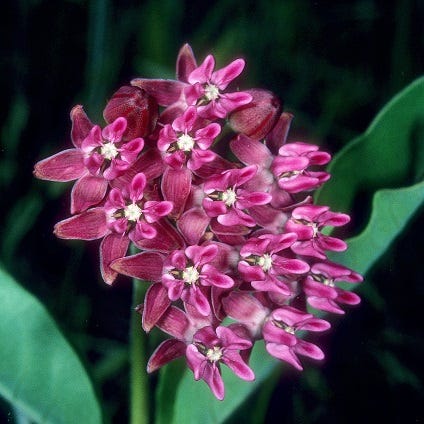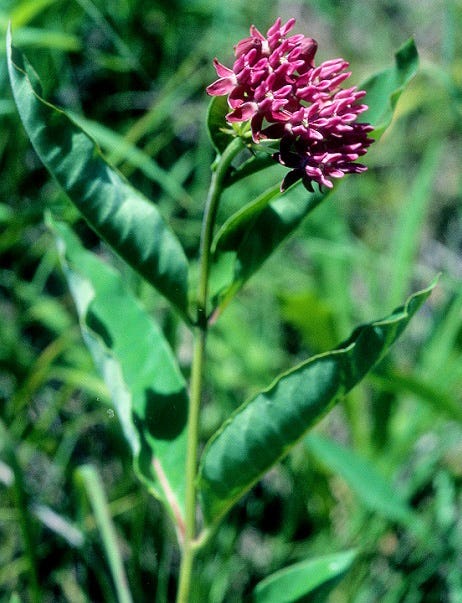by David Salman

Introducing Three New, Uncommon Milkweed Varieties
In an effort to assist gardeners planting more native plants and to help feed Monarch butterfly populations, High Country Gardens is excited to be adding three new milkweed species to our spring 2018 offerings.
Any milkweed species will attract adult butterflies to their flowers for a sip of nectar, but the regal Monarch is more selective when it comes to choosing milkweed plants on which their caterpillars will feed.
In general, when planting milkweed to provide caterpillar food, it's best to plant a milkweed species that are native to your region of the US. This is due to the fact that Monarchs from your region will seek out species that they have fed upon before.
Narrow Leaf Milkweed (Asclepias fascicularis)
Hardy in zones 6-10
Narrow Leaf Milkweed (Asclepias fascicularis) is a western native species has large clusters of white flowers and distinctive long, narrow leaves that make this native perennial a desirable landscape plant. It grows readily in all types of soil including clay and appreciates full sun exposure. And Narrow Leaf Milkweed can grow in both dry and moist growing conditions.
Their flowers are a magnet for all types of adult butterflies, not just Monarchs. So, it's a great choice for habitat gardens and meadow plantings. Some bird species, like Orioles, use the dead stems for nest building.
Recommend Growing Areas:
- As a garden ornamental, this species can be planted across most of the western US.
- To feed Monarch caterpillars, it is best planted in WA, OR, ID, CA and NV. Reference this USDA map to see where it is native and of most value to Monarchs.
Purple Milkweed (Asclepias purpurascens)
Hardy in zones 3-8

Purple Milkweed (Asclepias purpurascens) is an uncommon milkweed species that has large dark rose-pink flowers that are very showy and full of nectar to attract adult Monarchs and other butterfly species. Purple Milkweed spreads by reseeding and underground roots (rhizomes) and can establish large colonies in suitable habitat, so it's best planted in less used areas of your property, not in your prime flower beds.
It grows in most soil types, even dry clay and likes full sun.Purple Milkweed is xeric (water-wise) once established but appreciates additional water in drier climates.
Recommend Growing Areas:
- As a garden ornamental, this species can be planted across much of the US, but needs supplemental irrigation in areas receiving less than 25 inches of annual precipitation.
- To feed Monarch catterpillars, find your state on this USDA map that shows where the plant is native.
Davis Showy Milkweed (Asclepias speciosa 'Davis')
Hardy in zones 4-9

A selection of the widespread western native species, Davis Showy Milkweed (Asclepias speciosa 'Davis') is native to inland central CA. It has huge, fragrant 4 to 5 inch diameter light pink flower heads and large, highly ornamental silver leaves held on sturdy upright stems.
Davis Showy Milkweed grows as a clump-forming perennial and doesn't spread, making it invaluable as a well behaved plant for your perennial beds. And of course, it's a larval food plant for western Monarch populations.
Xeric (waterwise) once established, it grows well in a wide range of soils including clay and likes full sun conditions. Avoid planting it in low, water-collecting parts of your landscape as Davis Showy Milkweed doesn't like wet soils like its eastern relatives, A. syriaca and A. purpurescens.
Recommend Growing Areas:
- As a garden ornamental,'Davis' is suitable for use in much of the western US.
- To feed Monarch caterpillars, plant it in non-coastal CA, OR and WA.
Cultivation Notes

Most Asclepias species are late to wake up in the spring, and will often be shipped as dormant plants.
Don't despair if your potted milkweed is asleep above ground. The white roots and woody crown are alive just waiting for consistently warm weather to wake up and begin to grow.
Go ahead and plant the dormant plants.
- Don't up-pot them to hold for later planting.
- Prepare the soil, plant them, mulch, water thoroughly and wait.
- Once the weather warms and the plants begin to grow, water thoroughly but infrequently (once every week to 10 days)
- Use our root stimulator combo pack (liquid seaweed and SuperThrive) when you water during the first few months in the ground.
- Avoid fertilizing new transplants, especially with water-soluble chemical fertilizers. Good soil preparation and root stimulator is all they need for their first year.
Often times, Milkweeds won't grow much their first season in the ground, so be patient. They are establishing their root system and crown. By the second growing season, the plants will begin to get bigger and look more robust.
Asclepias species are an odd bunch and don't behave like many other more familiar perennials. So be patient and accept their quirky nature.
© All articles are copyrighted by High Country Gardens. Republishing an entire High Country Gardens blog post or article is prohibited without written permission. Please feel free to share a short excerpt with a link back to the article on social media websites, such as Facebook and Pinterest.